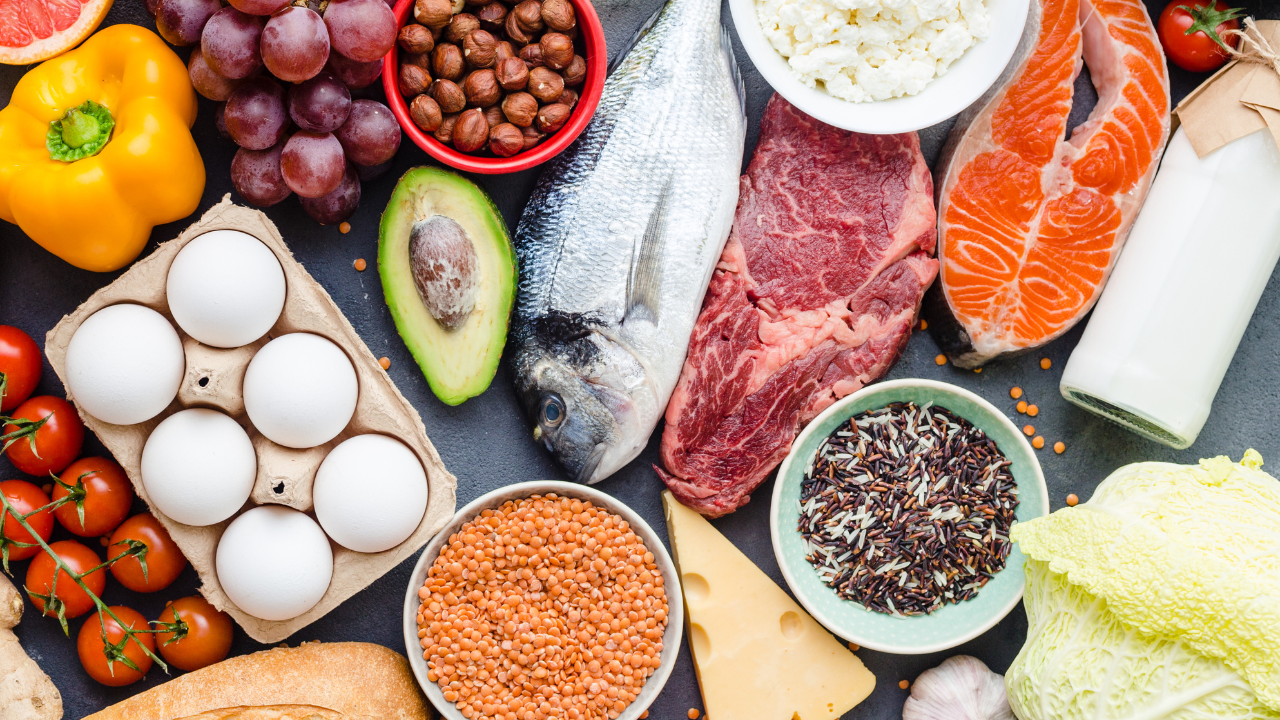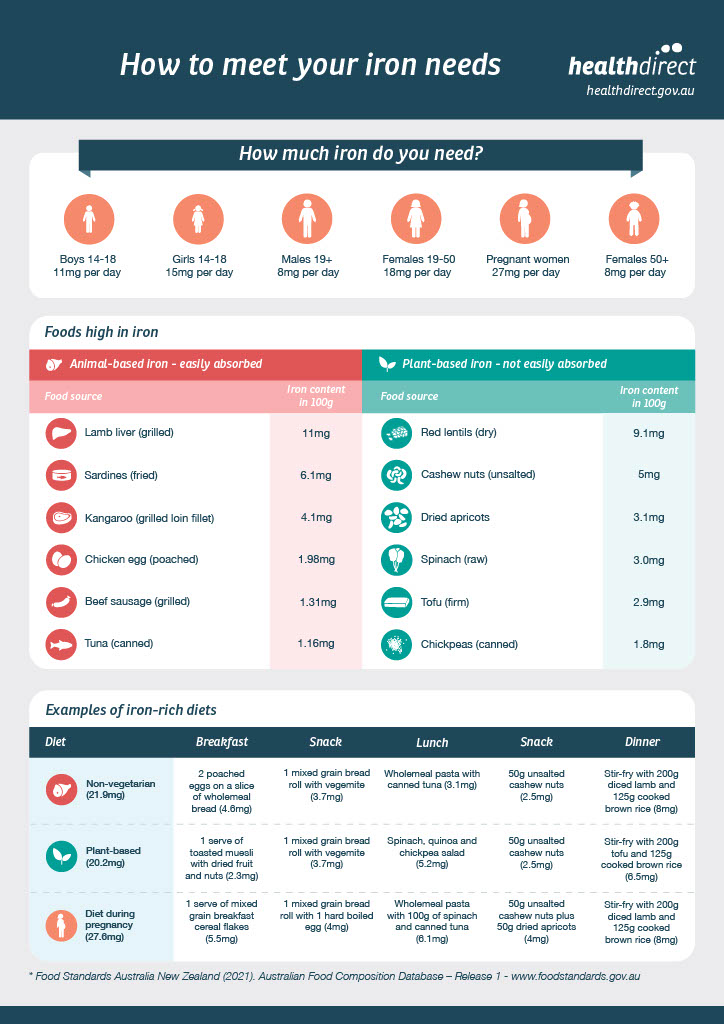Essential Tips and Nutrient-Rich Foods to Boost Your Iron Levels Naturally

If you feel lethargic, feel like you catch every sniffle going around, struggle to lose weight, or aren’t as productive as you once were, it may be time to check your iron levels.
In Australia, over 1.1 million people are iron deficient. And approximately 2 billion people around the world are iron deficient. And while it is not limited to iron deficiency and anaemia are most common in women. Menstruation, pregnancy, menopause, and diet trends are contributing factors.
The recommended daily iron intake for adult women 18 – 50 is 18mg. For women over 50 and adult males at any age, it is 8 mg. If you are pregnant, it is 27mg per day. In children, it ranges from 9mg to 15mg. Below is a simple graphic to help identify your iron requirements.

Iron is found in foods in two forms, heme iron derived from animal products and non-heme iron found in plant foods. Red meat and seafood are common heme iron sources. Liver and other organ meats are very high in iron, although they don’t appear regularly in most people’s diets. Liver capsules have become popular as an alternative iron supplement. Plant foods containing iron include whole grains, nuts, legumes, lentils and peas, some fruits and vegetables, and tofu.
Why is iron essential?
There is an established connection between iron deficiency and lowered immunity. Iron functions as part of proteins and is a co-factor of many enzymes used in metabolism. It is essential for many biochemical processes, including producing cellular energy (ATP), antioxidant protection, destruction of bacteria, viruses and microbes, carbohydrate metabolism, DNA synthesis, and niacin synthesis. Niacin is a B vitamin used by your body to support your nervous and digestive systems and keeps your skin healthy. Iron supports neurological development in children, and a lack of iron may be seen as a reduced attention span, inability to grasp concepts, delays in language and motor skills, and greater irritability.
Like all nutrients, iron holds no value unless we can absorb it, known as bioavailability. Heme iron is the easiest for our bodies to access, and if you are vegan or plant-based, you may need to eat more iron-rich vegetables to ensure adequate amounts of iron in your diet. To support the absorption of dietary iron, eat vitamin C-rich foods while you eat high-iron foods. For example, drink juice or include foods like broccoli, grapefruit, kiwi, leafy greens, melons, oranges, peppers, strawberries, and tomatoes. Combining your iron intake with vitamin C will increase the bioavailability of iron.
How food sources can impact iron absorption.
Vitamin C: Found in citrus fruits, red bell peppers, and tomatoes, vitamin C enhances the absorption of non-heme iron.
Heme Iron: Found in animal food sources, such as red meat, chicken, and salmon, it is more readily absorbed by the body and less likely to be affected by inhibitory substances.
Healthy Fats: Ingredients such as nuts, seeds, olive oil, and avocados contain healthy fats that can support iron absorption.
Calcium: Found in dairy foods and leafy greens, it can inhibit non-heme iron absorption if consumed in large amounts with iron-rich foods.
Vitamin E: Found in almonds and sunflower seeds, vitamin E enhances iron absorption.
Fibre and phytonutrients: Whole grains, vegetables, and fruits influence digestion and absorption. These can inhibit iron bioavailability; however, it seems dependent on the quantity, and some polyphenols increase iron absorption. Research tells us that most people don’t eat the required amount of fruits and vegetables, let alone eat them in excess! Therefore don’t let this get in the way of amping up your plant intake!
Remember that none of these nutrients are consumed alone, and it is a balanced diet that optimises iron absorption and supports your nutritional well-being.
Iron deficiency
Common symptoms of iron deficiency include fatigue, dizziness and headaches, breathing difficulties, pale or yellow skin, and cold feet and hands. Managing your iron levels can improve your energy levels, support your immune system and improve your general well-being.
If you are experiencing these symptoms, I encourage you to have your iron levels checked with your health practitioner. You may need a period of supplementation to replenish your stores.
Below are my go-to recipes to help support the bioavailability and absorption of iron. Each recipe has a side dish offering an extra dose of vitamin C. Click on the title of the recipe to be taken to its page.
Beef & Liver Meatballs with Grain Free Tabbouleh
Crispy Lemon Caper Monkfish & Grilled Cabbage with Creamy Lime Dressing
If you want to change some poor habits around food and lifestyle, find out more about my self-guided Seasonal Nutrition Reset programs here.
And as always, remember your reasons, your health, your mission and the people you love.
OM xx

Blog posts are not intended to provide medical advice or take the place of medical advice and treatment from your doctor. Readers are advised to consult their qualified health professionals regarding specific health questions. Ocea Marie does not take any responsibility for possible health consequences for anyone reading or following the information available on the blog. All readers, especially those taking prescription or over-the-counter medications, should consult their doctor before beginning any nutrition or supplement program.
Imagine transforming just a few minutes each day into a powerful practice that can guide you from stress to calm, foster emotional well-being and inner peace?
You can! With my FREE Mindful Moments: A 5-Day Journal with Prompts for Busy Women.
Plus, you'll receive an exclusive mindfulness meditation audio to move you from overwhelm to calm in a few moments. Don’t miss out on this transformative gift!
